technical data FIAT SCUDO 2011 Owner handbook (in English)
[x] Cancel search | Manufacturer: FIAT, Model Year: 2011, Model line: SCUDO, Model: FIAT SCUDO 2011Pages: 210, PDF Size: 3.29 MB
Page 39 of 210
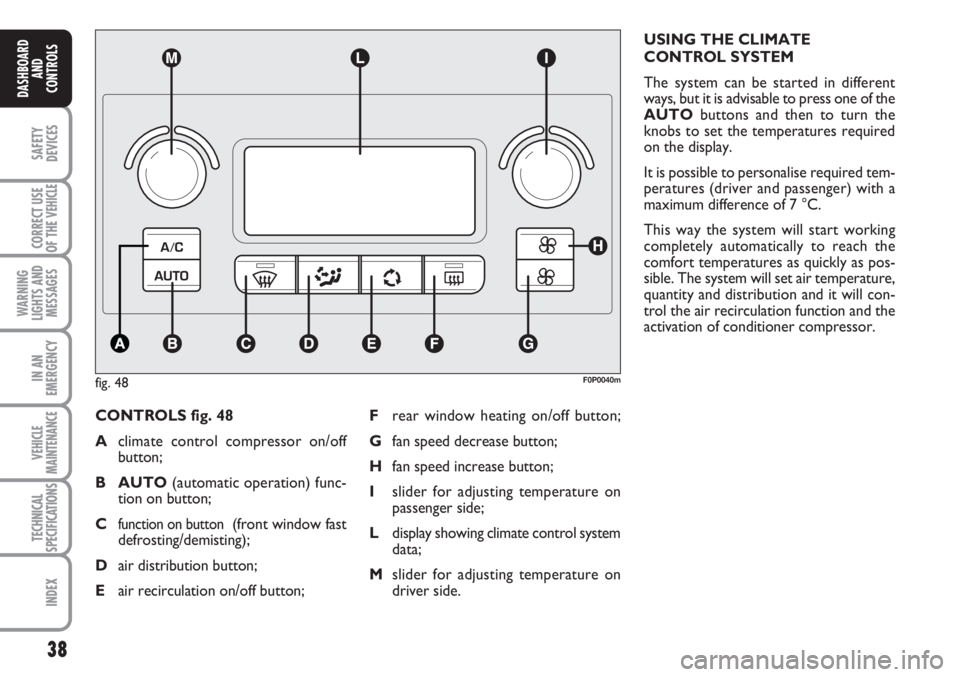
38
SAFETY
DEVICES
CORRECT USE
OF THE
VEHICLE
WARNING
LIGHTS AND
MESSAGES
IN AN
EMERGENCY
VEHICLE
MAINTENANCE
TECHNICAL
SPECIFICATIONS
INDEX
DASHBOARD
AND
CONTROLS
CONTROLS fig. 48
Aclimate control compressor on/off
button;
B AUTO(automatic operation) func-
tion on button;
C
function on button (front window fast
defrosting/demisting);
Dair distribution button;
Eair recirculation on/off button;USING THE CLIMATE
CONTROL SYSTEM
The system can be started in different
ways, but it is advisable to press one of the
AUTObuttons and then to turn the
knobs to set the temperatures required
on the display.
It is possible to personalise required tem-
peratures (driver and passenger) with a
maximum difference of 7 °C.
This way the system will start working
completely automatically to reach the
comfort temperatures as quickly as pos-
sible. The system will set air temperature,
quantity and distribution and it will con-
trol the air recirculation function and the
activation of conditioner compressor.
fig. 48F0P0040m
Frear window heating on/off button;
Gfan speed decrease button;
Hfan speed increase button;
Islider for adjusting temperature on
passenger side;
Ldisplay showing climate control system
data;
Mslider for adjusting temperature on
driver side.
Page 93 of 210
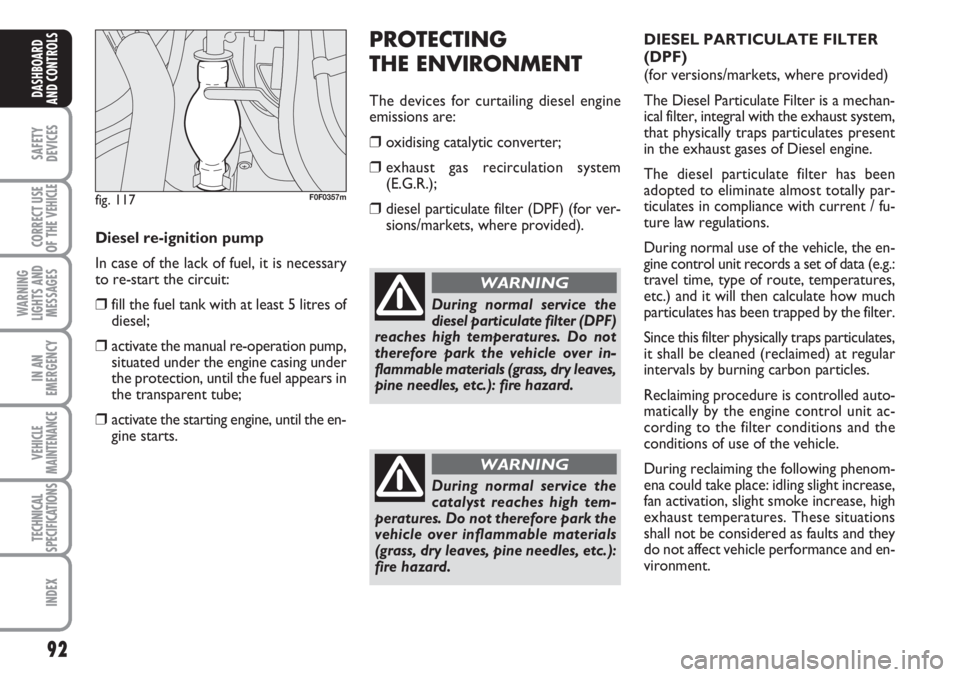
92
SAFETY
DEVICES
CORRECT USE
OF THE
VEHICLE
WARNING
LIGHTS AND
MESSAGES
IN AN
EMERGENCY
VEHICLE
MAINTENANCE
TECHNICAL
SPECIFICATIONS
INDEX
DASHBOARD
AND CONTROLS
DIESEL PARTICULATE FILTER
(DPF)
(for versions/markets, where provided)
The Diesel Particulate Filter is a mechan-
ical filter, integral with the exhaust system,
that physically traps particulates present
in the exhaust gases of Diesel engine.
The diesel particulate filter has been
adopted to eliminate almost totally par-
ticulates in compliance with current / fu-
ture law regulations.
During normal use of the vehicle, the en-
gine control unit records a set of data (e.g.:
travel time, type of route, temperatures,
etc.) and it will then calculate how much
particulates has been trapped by the filter.
Since this filter physically traps particulates,
it shall be cleaned (reclaimed) at regular
intervals by burning carbon particles.
Reclaiming procedure is controlled auto-
matically by the engine control unit ac-
cording to the filter conditions and the
conditions of use of the vehicle.
During reclaiming the following phenom-
ena could take place: idling slight increase,
fan activation, slight smoke increase, high
exhaust temperatures. These situations
shall not be considered as faults and they
do not affect vehicle performance and en-
vironment.
During normal service the
diesel particulate filter (DPF)
reaches high temperatures. Do not
therefore park the vehicle over in-
flammable materials (grass, dry leaves,
pine needles, etc.): fire hazard.
WARNING
During normal service the
catalyst reaches high tem-
peratures. Do not therefore park the
vehicle over inflammable materials
(grass, dry leaves, pine needles, etc.):
fire hazard.
WARNING
PROTECTING
THE ENVIRONMENT
The devices for curtailing diesel engine
emissions are:
❒oxidising catalytic converter;
❒ exhaust gas recirculation system
(E.G.R.);
❒diesel particulate filter (DPF) (for ver-
sions/markets, where provided).
Diesel re-ignition pump
In case of the lack of fuel, it is necessary
to re-start the circuit:
❒ fill the fuel tank with at least 5 litres of
diesel;
❒ activate the manual re-operation pump,
situated under the engine casing under
the protection, until the fuel appears in
the transparent tube;
❒ activate the starting engine, until the en-
gine starts.
fig. 117F0F0357m
Page 100 of 210
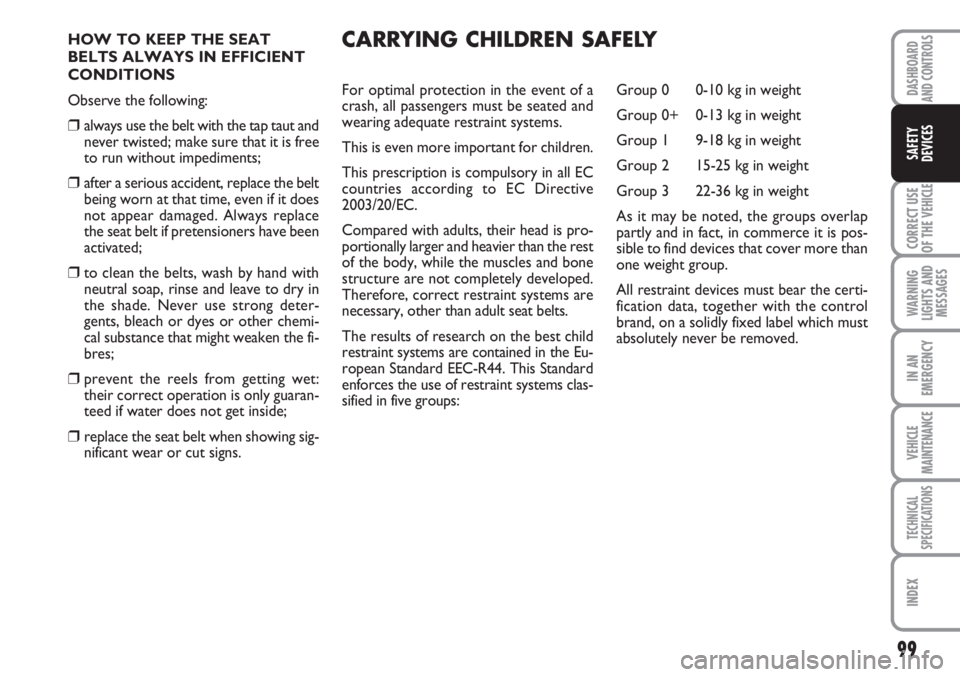
99
CORRECT USE
OF THE
VEHICLE
WARNING
LIGHTS AND
MESSAGES
IN AN
EMERGENCY
VEHICLE
MAINTENANCE
TECHNICAL
SPECIFICATIONS
INDEX
DASHBOARD
AND CONTROLS
SAFETY
DEVICES
HOW TO KEEP THE SEAT
BELTS ALWAYS IN EFFICIENT
CONDITIONS
Observe the following:
❒always use the belt with the tap taut and
never twisted; make sure that it is free
to run without impediments;
❒after a serious accident, replace the belt
being worn at that time, even if it does
not appear damaged. Always replace
the seat belt if pretensioners have been
activated;
❒to clean the belts, wash by hand with
neutral soap, rinse and leave to dry in
the shade. Never use strong deter-
gents, bleach or dyes or other chemi-
cal substance that might weaken the fi-
bres;
❒prevent the reels from getting wet:
their correct operation is only guaran-
teed if water does not get inside;
❒replace the seat belt when showing sig-
nificant wear or cut signs.For optimal protection in the event of a
crash, all passengers must be seated and
wearing adequate restraint systems.
This is even more important for children.
This prescription is compulsory in all EC
countries according to EC Directive
2003/20/EC.
Compared with adults, their head is pro-
portionally larger and heavier than the rest
of the body, while the muscles and bone
structure are not completely developed.
Therefore, correct restraint systems are
necessary, other than adult seat belts.
The results of research on the best child
restraint systems are contained in the Eu-
ropean Standard EEC-R44. This Standard
enforces the use of restraint systems clas-
sified in five groups: Group 0 0-10 kg in weight
Group 0+ 0-13 kg in weight
Group 1 9-18 kg in weight
Group 2 15-25 kg in weight
Group 3 22-36 kg in weight
As it may be noted, the groups overlap
partly and in fact, in commerce it is pos-
sible to find devices that cover more than
one weight group.
All restraint devices must bear the certi-
fication data, together with the control
brand, on a solidly fixed label which must
absolutely never be removed.
CARRYING CHILDREN SAFELY
Page 174 of 210
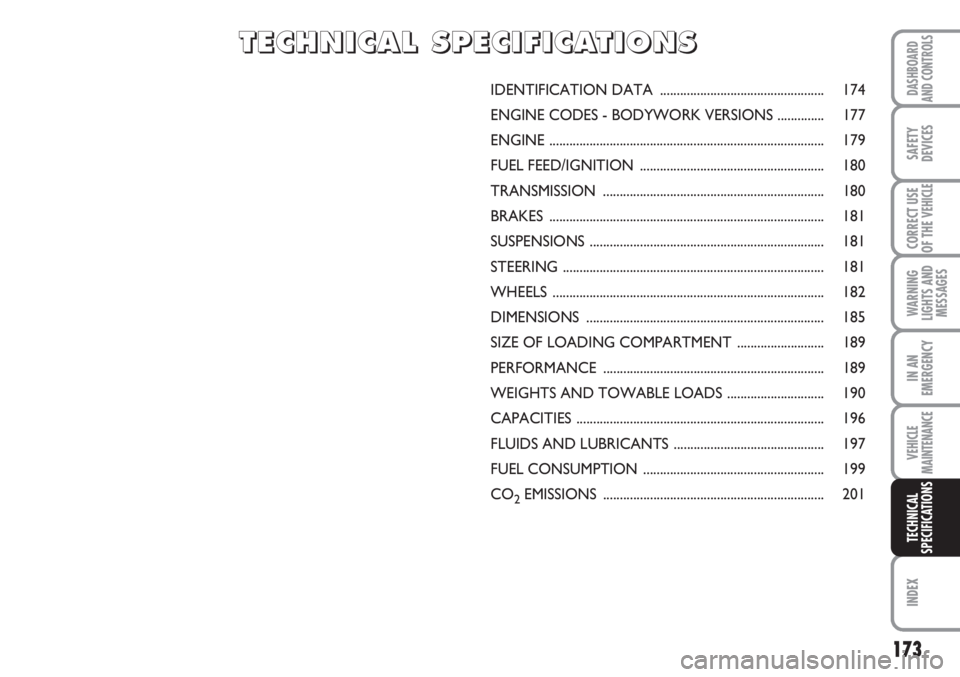
173
WARNING
LIGHTS AND
MESSAGES
INDEX
DASHBOARD
AND CONTROLS
SAFETY
DEVICES
CORRECT USE
OF THE
VEHICLE
IN AN
EMERGENCY
VEHICLE
MAINTENANCE
TECHNICAL
SPECIFICATIONS
IDENTIFICATION DATA ................................................. 174
ENGINE CODES - BODYWORK VERSIONS .............. 177
ENGINE .................................................................................. 179
FUEL FEED/IGNITION ....................................................... 180
TRANSMISSION .................................................................. 180
BRAKES .................................................................................. 181
SUSPENSIONS ...................................................................... 181
STEERING .............................................................................. 181
WHEELS ................................................................................. 182
DIMENSIONS ....................................................................... 185
SIZE OF LOADING COMPARTMENT .......................... 189
PERFORMANCE .................................................................. 189
WEIGHTS AND TOWABLE LOADS ............................. 190
CAPACITIES .......................................................................... 196
FLUIDS AND LUBRICANTS ............................................. 197
FUEL CONSUMPTION ...................................................... 199
CO
2EMISSIONS .................................................................. 201
T T
E E
C C
H H
N N
I I
C C
A A
L L
S S
P P
E E
C C
I I
F F
I I
C C
A A
T T
I I
O O
N N
S S
Page 175 of 210
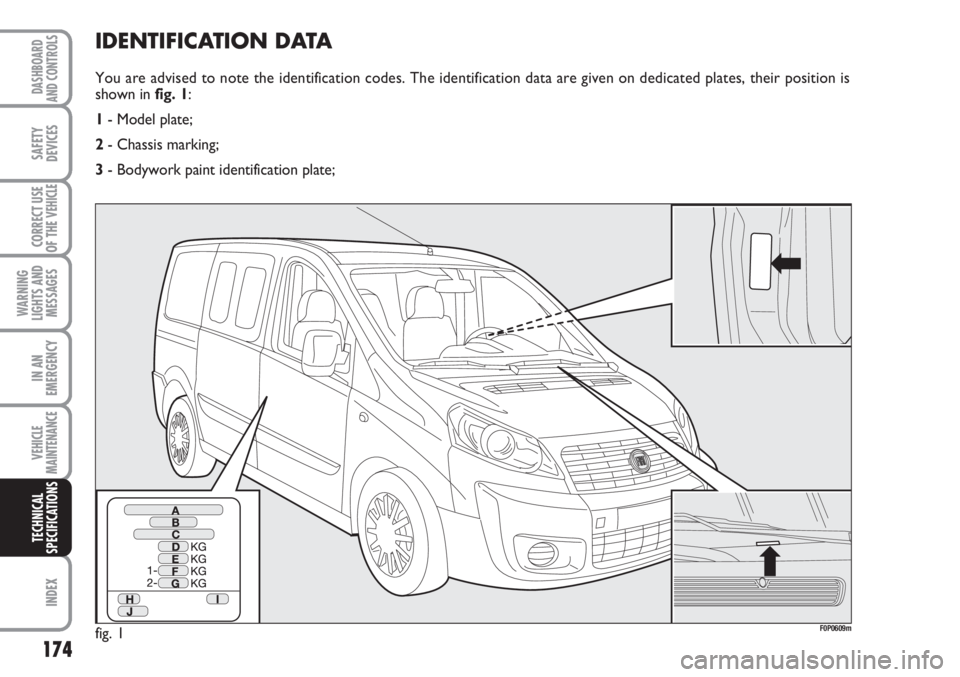
174
WARNING
LIGHTS AND
MESSAGES
INDEX
DASHBOARD
AND CONTROLS
SAFETY
DEVICES
CORRECT USE
OF THE
VEHICLE
IN AN
EMERGENCY
VEHICLE
MAINTENANCE
TECHNICAL
SPECIFICATIONS
IDENTIFICATION DATA
You are advised to note the identification codes. The identification data are given on dedicated plates, their position is
shown in fig. 1:
1- Model plate;
2- Chassis marking;
3- Bodywork paint identification plate;
fig. 1F0P0609m
Page 204 of 210
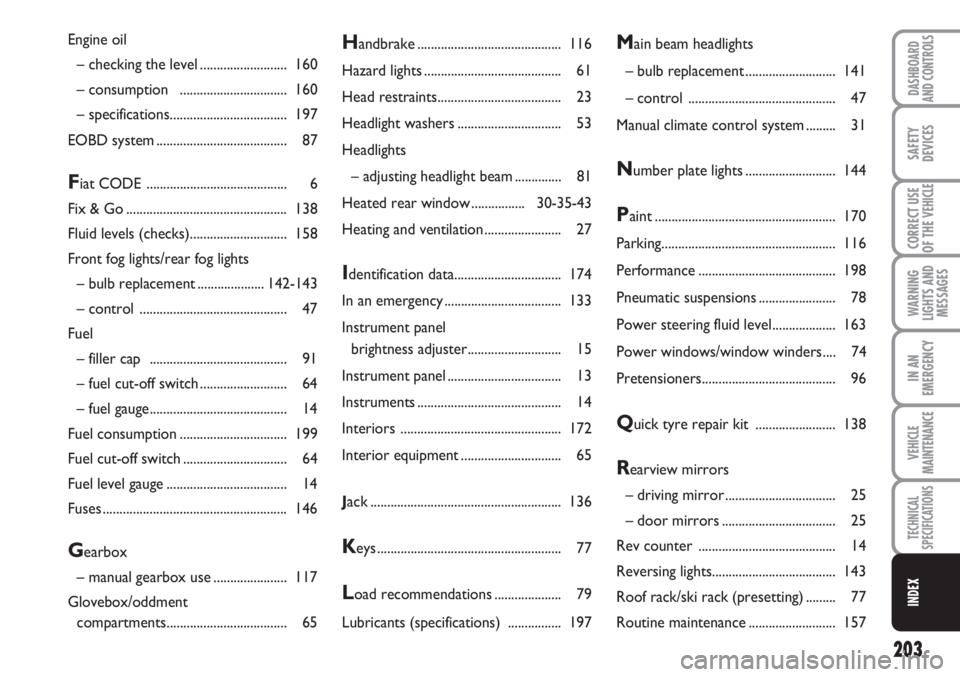
203
WARNING
LIGHTS AND
MESSAGES
DASHBOARD
AND CONTROLS
SAFETY
DEVICES
CORRECT USE
OF THE
VEHICLE
IN AN
EMERGENCY
VEHICLE
MAINTENANCE
TECHNICAL
SPECIFICATIONS
INDEX
Handbrake ........................................... 116
Hazard lights ......................................... 61
Head restraints..................................... 23
Headlight washers............................... 53
Headlights
– adjusting headlight beam .............. 81
Heated rear window................30-35-43
Heating and ventilation ....................... 27
Identification data................................ 174
In an emergency ................................... 133
Instrument panel
brightness adjuster............................ 15
Instrument panel.................................. 13
Instruments........................................... 14
Interiors ................................................ 172
Interior equipment.............................. 65
Jack ......................................................... 136
Keys ....................................................... 77
Load recommendations.................... 79
Lubricants (specifications) ................ 197
Main beam headlights
– bulb replacement ........................... 141
– control ............................................ 47
Manual climate control system ......... 31
Number plate lights ........................... 144
Paint ...................................................... 170
Parking.................................................... 116
Performance ......................................... 198
Pneumatic suspensions ....................... 78
Power steering fluid level................... 163
Power windows/window winders .... 74
Pretensioners........................................ 96
Quick tyre repair kit ........................ 138
Rearview mirrors
– driving mirror................................. 25
– door mirrors .................................. 25
Rev counter ......................................... 14
Reversing lights..................................... 143
Roof rack/ski rack (presetting) ......... 77
Routine maintenance.......................... 157 Engine oil
– checking the level .......................... 160
– consumption ................................ 160
– specifications................................... 197
EOBD system....................................... 87
Fiat CODE .......................................... 6
Fix & Go................................................ 138
Fluid levels (checks)............................. 158
Front fog lights/rear fog lights
– bulb replacement ....................142-143
– control ............................................ 47
Fuel
– filler cap ......................................... 91
– fuel cut-off switch.......................... 64
– fuel gauge......................................... 14
Fuel consumption................................ 199
Fuel cut-off switch............................... 64
Fuel level gauge.................................... 14
Fuses....................................................... 146
Gearbox
– manual gearbox use ...................... 117
Glovebox/oddment
compartments.................................... 65
Page 205 of 210
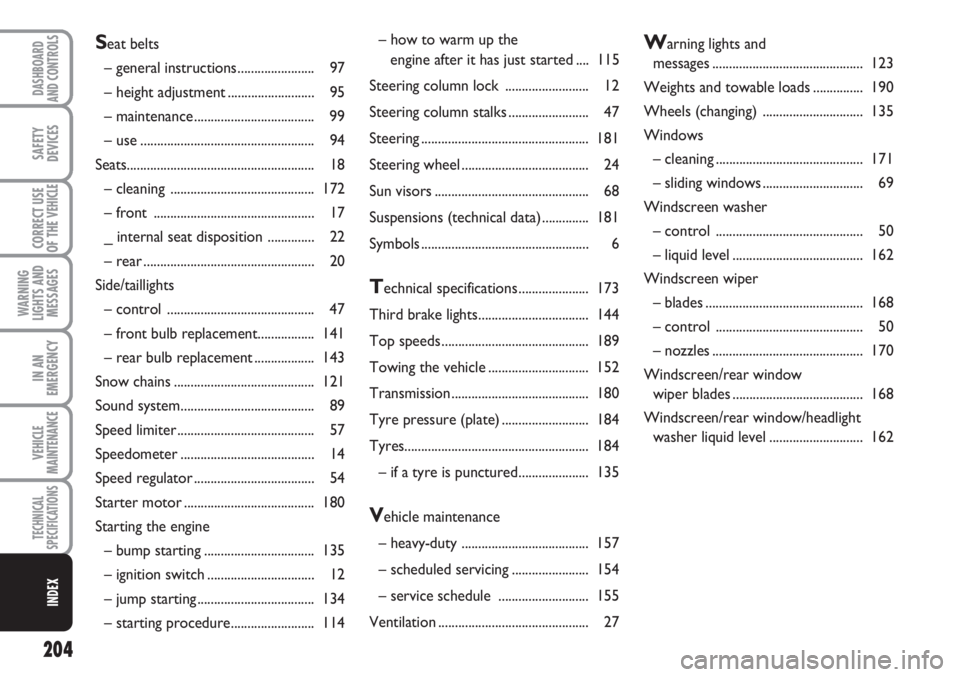
204
WARNING
LIGHTS AND
MESSAGES
DASHBOARD
AND CONTROLS
SAFETY
DEVICES
CORRECT USE
OF THE
VEHICLE
IN AN
EMERGENCY
VEHICLE
MAINTENANCE
TECHNICAL
SPECIFICATIONS
INDEX
– how to warm up the
engine after it has just started .... 115
Steering column lock ......................... 12
Steering column stalks........................ 47
Steering.................................................. 181
Steering wheel...................................... 24
Sun visors .............................................. 68
Suspensions (technical data) .............. 181
Symbols.................................................. 6
Technical specifications..................... 173
Third brake lights................................. 144
Top speeds............................................ 189
Towing the vehicle.............................. 152
Transmission......................................... 180
Tyre pressure (plate).......................... 184
Tyres....................................................... 184
– if a tyre is punctured..................... 135
Vehicle maintenance
– heavy-duty ...................................... 157
– scheduled servicing....................... 154
– service schedule ........................... 155
Ventilation ............................................. 27
Warning lights and
messages............................................. 123
Weights and towable loads ............... 190
Wheels (changing) .............................. 135
Windows
– cleaning............................................ 171
– sliding windows.............................. 69
Windscreen washer
– control ............................................ 50
– liquid level ....................................... 162
Windscreen wiper
– blades............................................... 168
– control ............................................ 50
– nozzles............................................. 170
Windscreen/rear window
wiper blades....................................... 168
Windscreen/rear window/headlight
washer liquid level............................ 162Seat belts
– general instructions....................... 97
– height adjustment .......................... 95
– maintenance.................................... 99
– use .................................................... 94
Seats........................................................ 18
– cleaning ........................................... 172
– front ................................................ 17
_ internal seat disposition .............. 22
– rear................................................... 20
Side/taillights
– control ............................................ 47
– front bulb replacement................. 141
– rear bulb replacement.................. 143
Snow chains .......................................... 121
Sound system........................................ 89
Speed limiter......................................... 57
Speedometer........................................ 14
Speed regulator.................................... 54
Starter motor....................................... 180
Starting the engine
– bump starting ................................. 135
– ignition switch................................ 12
– jump starting ................................... 134
– starting procedure......................... 114
Page 210 of 210
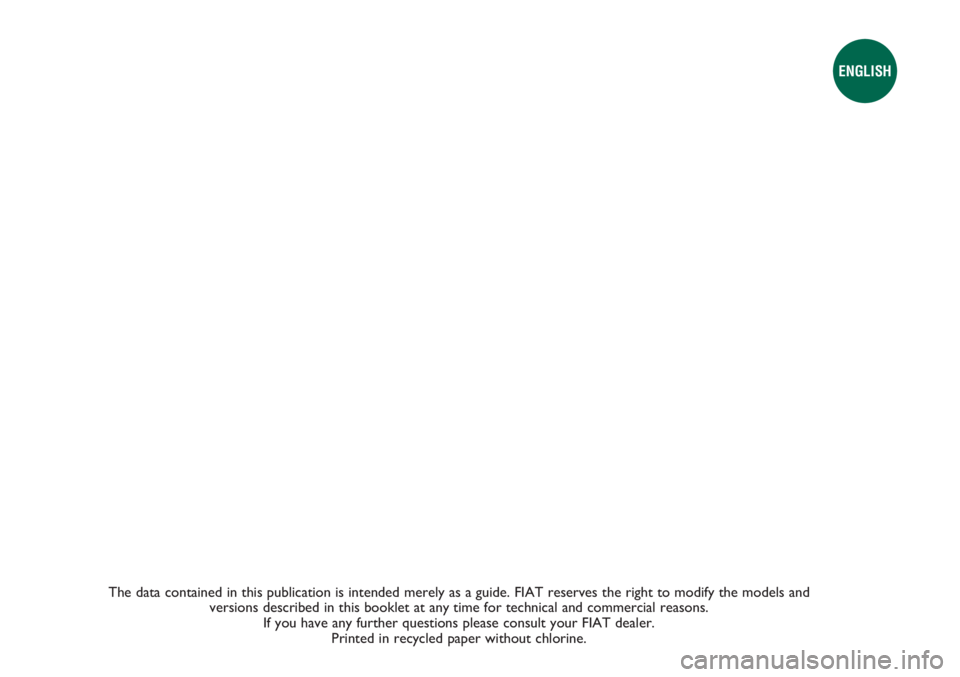
The data contained in this publication is intended merely as a guide. FIAT reserves the right to modify the models and
versions described in this booklet at any time for technical and commercial reasons.
If you have any further questions please consult your FIAT dealer.
Printed in recycled paper without chlorine.
ENGLISH